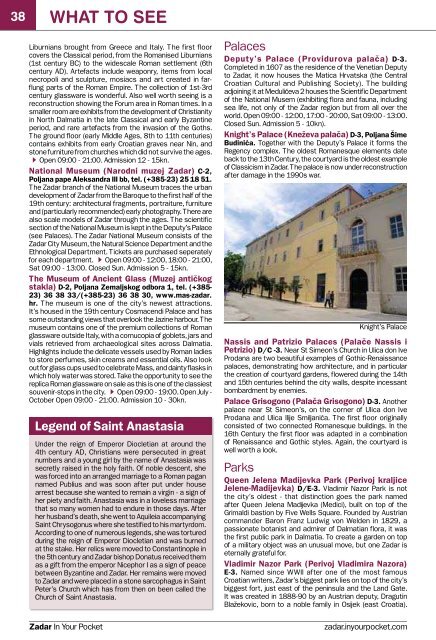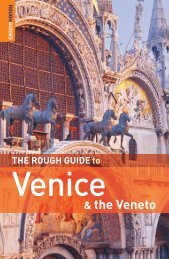You also want an ePaper? Increase the reach of your titles
YUMPU automatically turns print PDFs into web optimized ePapers that Google loves.
38 What <strong>to</strong> see<br />
What <strong>to</strong> see<br />
39<br />
Liburnians brought from Greece and Italy. The first floor<br />
covers the Classical period, from the Romanised Liburnians<br />
(1st century BC) <strong>to</strong> the widescale Roman settlement (6th<br />
century AD). Artefacts include weaponry, items from local<br />
necropoli and sculpture, mosiacs and art created in farflung<br />
parts of the Roman Empire. The collection of 1st-3rd<br />
century glassware is wonderful. Also well worth seeing is a<br />
reconstruction showing the Forum area in Roman times. In a<br />
smaller room are exhibits from the development of Christianity<br />
in North Dalmatia in the late Classical and early Byzantine<br />
period, and rare artefacts from the invasion of the Goths.<br />
The ground floor (early Middle Ages, 8th <strong>to</strong> 11th centuries)<br />
contains exhibits from early Croatian graves near Nin, and<br />
s<strong>to</strong>ne furniture from churches which did not survive the ages.<br />
QOpen 09:00 - 21:00. Admission 12 - 15kn.<br />
National Museum (Narodni muzej Zadar) C-2,<br />
Poljana pape Aleksandra III bb, tel. (+385-23) 25 18 51.<br />
The Zadar branch of the National Museum traces the urban<br />
development of Zadar from the Baroque <strong>to</strong> the first half of the<br />
19th century: architectural fragments, portraiture, furniture<br />
and (particularly recommended) early pho<strong>to</strong>graphy. There are<br />
also scale models of Zadar through the ages. The scientific<br />
section of the National Museum is kept in the Deputy’s Palace<br />
(see Palaces). The Zadar National Museum consists of the<br />
Zadar City Museum, the Natural Science Department and the<br />
Ethnological Department. Tickets are purchased seperately<br />
for each department. QOpen 09:00 - 12:00, 18:00 - 21:00,<br />
Sat 09:00 - 13:00. Closed Sun. Admission 5 - 15kn.<br />
The Museum of Ancient Glass (Muzej antičkog<br />
stakla) D-2, Poljana Zemaljskog odbora 1, tel. (+385-<br />
23) 36 38 33/(+385-23) 36 38 30, www.mas-zadar.<br />
hr. The museum is one of the city’s newest attractions.<br />
It’s housed in the 19th century Cosmacendi Palace and has<br />
some outstanding views that overlook the Jazine harbour. The<br />
museum contains one of the premium collections of Roman<br />
glassware outside Italy, with a cornucopia of goblets, jars and<br />
vials retrieved from archaeological sites across Dalmatia.<br />
Highlights include the delicate vessels used by Roman ladies<br />
<strong>to</strong> s<strong>to</strong>re perfumes, skin creams and essential oils. Also look<br />
out for glass cups used <strong>to</strong> celebrate Mass, and dainty flasks in<br />
which holy water was s<strong>to</strong>red. Take the opportunity <strong>to</strong> see the<br />
replica Roman glassware on sale as this is one of the classiest<br />
souvenir-s<strong>to</strong>ps in the city. QOpen 09:00 - 19:00. Open July -<br />
Oc<strong>to</strong>ber Open 09:00 - 21:00. Admission 10 - 30kn.<br />
Legend of Saint Anastasia<br />
Under the reign of Emperor Diocletian at around the<br />
4th century AD, Christians were persecuted in great<br />
numbers and a young girl by the name of Anastasia was<br />
secretly raised in the holy faith. Of noble descent, she<br />
was forced in<strong>to</strong> an arranged marriage <strong>to</strong> a Roman pagan<br />
named Publius and was soon after put under house<br />
arrest because she wanted <strong>to</strong> remain a virgin - a sign of<br />
her piety and faith. Anastasia was in a loveless marriage<br />
that so many women had <strong>to</strong> endure in those days. After<br />
her husband’s death, she went <strong>to</strong> Aquileia accompanying<br />
Saint Chrysogonus where she testified <strong>to</strong> his martyrdom.<br />
According <strong>to</strong> one of numerous legends, she was <strong>to</strong>rtured<br />
during the reign of Emperor Diocletian and was burned<br />
at the stake. Her relics were moved <strong>to</strong> Constantinople in<br />
the 5th century and Zadar bishop Donatus received them<br />
as a gift from the emperor Nicephor I as a sign of peace<br />
between Byzantine and Zadar. Her remains were moved<br />
<strong>to</strong> Zadar and were placed in a s<strong>to</strong>ne sarcophagus in Saint<br />
Peter’s Church which has from then on been called the<br />
Church of Saint Anastasia.<br />
Palaces<br />
Deputy’s Palace (Providurova palača) D-3.<br />
Completed in 1607 as the residence of the Venetian Deputy<br />
<strong>to</strong> Zadar, it now houses the Matica Hrvatska (the Central<br />
Croatian Cultural and Publishing Society). The building<br />
adjoining it at Medulićeva 2 houses the Scientific Department<br />
of the National Musem (exhibiting flora and fauna, including<br />
sea life, not only of the Zadar region but from all over the<br />
world. Open 09:00 - 12:00, 17:00 - 20:00, Sat 09:00 - 13:00.<br />
Closed Sun. Admission 5 - 10kn).<br />
Knight’s Palace (Kneževa palača) D-3, Poljana Šime<br />
Budinića. Together with the Deputy’s Palace it forms the<br />
Regency complex. The oldest Romanesque elements date<br />
back <strong>to</strong> the 13th Century, the courtyard is the oldest example<br />
of Classicism in Zadar. The palace is now under reconstruction<br />
after damage in the 1990s war.<br />
Knight’s Palace<br />
Nassis and Patrizio Palaces (Palače Nassis i<br />
Petrizio) D/C -3. Near St Simeon’s Church in Ulica don Ive<br />
Prodana are two beautiful examples of Gothic-Renaissance<br />
palaces, demonstrating how architecture, and in particular<br />
the creation of courtyard gardens, flowered during the 14th<br />
and 15th centuries behind the city walls, despite incessant<br />
bombardment by enemies.<br />
Palace Grisogono (Palača Grisogono) D-3. Another<br />
palace near St Simeon’s, on the corner of Ulica don Ive<br />
Prodana and Ulica Ilije Smiljanića. The first floor originally<br />
consisted of two connected Romanesque buildings. In the<br />
16th Century the first floor was adapted in a combination<br />
of Renaissance and Gothic styles. Again, the courtyard is<br />
well worth a look.<br />
Parks<br />
Queen Jelena Madijevka Park (Perivoj kraljice<br />
Jelene-Madijevka) D/E-3. Vladimir Nazor Park is not<br />
the city’s oldest - that distinction goes the park named<br />
after Queen Jelena Madijevka (Medici), built on <strong>to</strong>p of the<br />
Grimaldi bastion by Five Wells Square. Founded by Austrian<br />
commander Baron Franz Ludwig von Welden in 1829, a<br />
passionate botanist and admirer of Dalmatian flora, it was<br />
the first public park in Dalmatia. To create a garden on <strong>to</strong>p<br />
of a military object was an unusual move, but one Zadar is<br />
eternally grateful for.<br />
Vladimir Nazor Park (Perivoj Vladimira Nazora)<br />
E-3. Named since WWII after one of the most famous<br />
Croatian writers, Zadar’s biggest park lies on <strong>to</strong>p of the city’s<br />
biggest fort, just east of the peninsula and the Land Gate.<br />
It was created in 1888-90 by an Austrian deputy, Dragutin<br />
Blažekovic, born <strong>to</strong> a noble family in Osijek (east Croatia).<br />
Despite working for the Austrians, he was a supporter of<br />
Croatian rights, and resigned when the Austrians refused<br />
<strong>to</strong> concede them. He left something beautiful <strong>to</strong> the city - a<br />
richly planted park with winding pathways, a pond, and an<br />
elevation giving great views of the sea. He died three years<br />
after it was completed, and the park was named after him<br />
- against his wishes.<br />
Religious collection<br />
Silver and Gold of the<br />
City of Zadar (Zla<strong>to</strong> i<br />
srebro Zadra) B-3, Trg<br />
opatice Čike 1, tel. (+385-<br />
23) 25 04 96/(+385-23)<br />
25 48 20. If you come <strong>to</strong><br />
Zadar you must see the<br />
Forum and St Donatus. If<br />
you only see one other thing,<br />
make it the Silver and Gold<br />
of Zadar. It’s housed in the<br />
Benedictine convent of St<br />
Mary’s, where it has been<br />
guarded by nuns since the<br />
end of the Second World<br />
War. It forms the Permanent<br />
Exhibition of Religious Art, one of the most important cultural<br />
reposi<strong>to</strong>ries in Croatia. The city has enjoyed various periods<br />
of flowering of arts and culture, and the work of local gold and<br />
silversmiths (including Italians and Venetians resident in the<br />
city) is absolutely stunning, spanning the millennium between<br />
the 8th and 18th Centuries. The collection includes reliquaries<br />
for either entire saints or parts of them (e.g. hands, arms and<br />
heads), crucifixes, paintings, and vestements interwoven<br />
with gold and silver thread. The collection is presented in<br />
intimate and atmospheric surroundings, and is guaranteed<br />
<strong>to</strong> leave the most resolute non-believer awestruck. On the<br />
Pho<strong>to</strong> Workshop in Sestrunj<br />
ground floor there is also a reconstruction of the former<br />
chapel of St Nediljica and examples of Romanesque masonry.<br />
Q Open 10:00 - 13:00, 18:00 - 20:00. Sun 10:00 - 13:00.<br />
Admission 15 - 20kn.<br />
Silver Casket of St Simeon (Srebrna raka sv.<br />
Šime) D-3, Trg Petra Zoranića 7, tel. (+385-23) 21 17<br />
05. In the church of the same name, a gilded silver casket<br />
on the altar is raised on the outstretched arms of four bronze<br />
angels. It contains the remains of the popular saint-protec<strong>to</strong>r<br />
of the city. Commissioned in 1381 by Elizabeth, wife of<br />
Croat-Hungarian King Ludwig I of Anjou, it’s one of the finest<br />
examples of the work of Zadar’s silversmiths, and inside and<br />
out shows in intricate detail scenes from the saint’s life and<br />
the city’s his<strong>to</strong>ry.<br />
Locals say that a merchant who was shipping the body of St<br />
Simeon from the Holy Land <strong>to</strong> Venice was caught in a s<strong>to</strong>rm,<br />
and sought shelter here. He fell ill, and before he died had the<br />
body buried, but <strong>to</strong>ld the nurses taking care of him that they<br />
would find something interesting in his documents. They found<br />
an inscription of the powers of the saint around his neck, and<br />
asked three local priests <strong>to</strong> dig up the grave that night. Not yet<br />
knowing the true <strong>nature</strong> of the occupant of the grave, visions<br />
appeared <strong>to</strong> them, and St Simeon has been revered in Zadar<br />
ever since. The silver casket of St. Simeon can be viewed daily<br />
and his remains will be shown <strong>to</strong> the public on his patron day,<br />
Oc<strong>to</strong>ber the 8th. Q Open 08:30 - 12:00.<br />
The Sacred Art Collection of St Francis’ Monastery<br />
(Riznica samostana sv. Frane) Trg sv. Frane 1, tel.<br />
(+385-23) 25 04 68. The monastery has a rich collection<br />
of religious art, highlights of which include a 12th century<br />
painted Romanesque crucifix and a 15th century polyptych<br />
from the island of Ugljan which is a fine example of Gothic<br />
painting in Croatia. There are also ancient incunabula,<br />
documents, liturgical vessels and more. QOpen 09:00 -<br />
18:00. Admission 5 - 15kn.<br />
Zadar In Your Pocket<br />
zadar.inyourpocket.com<br />
zadar.inyourpocket.com<br />
Summer 2011







